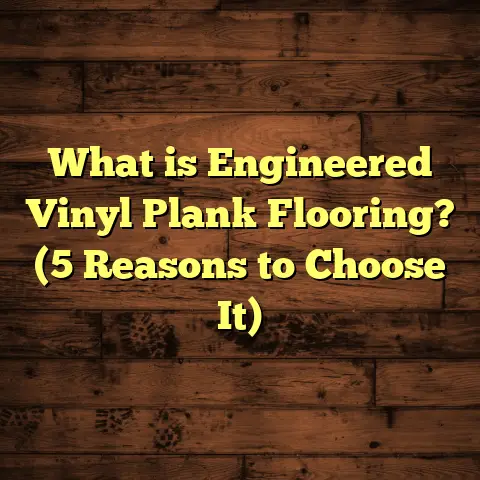What is a Floating Kitchen Floor? (5 Benefits You Must Know)
Trends in kitchen design have shifted a lot over the years, and one change that really caught my attention is the rise of floating kitchen floors. If you’re thinking about updating your kitchen, you might have come across this term and wondered what it means exactly. I’ve installed countless floors in kitchens, and floating floors have become a top pick for many homeowners. Let me walk you through what floating kitchen floors are, why they matter, and the benefits they bring to your home.
What Is a Floating Kitchen Floor?
So, what exactly is a floating kitchen floor? Simply put, it’s a type of floor installation where the flooring planks or tiles aren’t nailed or glued down to the subfloor. Instead, these pieces lock together and “float” above the subfloor, held in place by their interlocking edges.
Think of it like a jigsaw puzzle sitting on top of an underlayment rather than being fixed permanently. This method is different from traditional installation where the flooring is directly attached to the floor base.
Floating floors can be made from various materials, including laminate, engineered hardwood, vinyl, or even some types of tile. The key is the installation system — usually a tongue-and-groove or click-lock mechanism — that allows the planks to snap together without adhesives or nails.
Technical Specs & Manufacturing
When I choose floating floors for kitchens, I often recommend engineered hardwood or high-quality laminate. Here’s why: engineered hardwood has a multi-layer construction. It typically consists of a hardwood veneer on top (about 1/16 to 1/8 inch thick) bonded to several layers of plywood underneath. This layered build gives it stability against moisture and temperature changes — perfect for kitchens where spills and humidity happen.
Laminate flooring, on the other hand, starts with a fiberboard core topped with a photographic layer that mimics wood or stone and finished with a tough wear layer made from melamine resin. The manufacturing process involves high-pressure lamination that ensures durability and scratch resistance.
Both types use precision milling to create tongue-and-groove edges that lock tightly during installation.
The thickness of floating floor planks usually ranges from 7mm to 12mm but can go up to 15mm for engineered hardwood. The thickness contributes to comfort and noise reduction but also influences how well the floor resists indentations or impacts.
Underlayment: More Than Just a Cushion
A big part of floating floor installation is the underlayment — a thin layer placed between the subfloor and flooring planks. It can be foam, cork, rubber, or felt material designed to:
- Absorb sound and reduce footsteps noise
- Provide cushioning for comfort underfoot
- Act as a moisture barrier preventing water from reaching the floorboards
- Help smooth out minor imperfections in the subfloor
Choosing the right underlayment is critical for kitchen floors because moisture exposure is higher than in other rooms. For instance, I always recommend underlayments with built-in vapor barriers or adding a separate plastic sheet beneath if moisture is a concern.
Why Floating Floors Work Well in Kitchens
Kitchens present unique challenges for flooring: constant foot traffic, occasional spills, temperature fluctuations from cooking appliances, and even uneven subfloors due to plumbing work below. Floating floors handle these better than many traditional options because:
- Their interlocking system can accommodate slight expansion and contraction without buckling.
- Underlayments offer moisture protection.
- Installation doesn’t require puncturing the floor with nails, which can lead to weak spots.
My Experience With Floating Kitchen Floors
I remember the first time I installed a floating floor in a client’s kitchen about six years ago. They wanted something durable but stylish that didn’t take forever to install. The floating floor option saved us days compared to traditional nail-down hardwood. Plus, when we finished, the space felt modern and clean.
Since then, I’ve seen more people choose floating floors because they offer flexibility and convenience without sacrificing looks. For example, one customer had an old uneven concrete slab under their kitchen. Floating floors allowed us to install an underlayment that smoothed out minor bumps without expensive leveling work.
Another time, I installed a floating vinyl plank floor in a rental property’s kitchen. The landlord appreciated how simple it was to replace damaged planks without disturbing tenants. This flexibility is something I often highlight when helping clients decide between flooring types.
5 Benefits You Must Know About Floating Kitchen Floors
1. Easy and Fast Installation
One thing I love about floating floors is how quick they go down. No glue drying time or nailing means you can often finish a kitchen floor in just one day if you’re prepared.
And if you’re doing it yourself? Floating floors are very beginner-friendly because the planks just click together. No special tools beyond a saw and tapping block needed.
According to industry data, floating floors can reduce installation time by up to 50% compared to traditional hardwood installation. That’s a big deal if you want your kitchen back quickly.
Here’s something else: Unlike glued floors that require curing times before walking on them, floating floors are walkable immediately after installation. This means less downtime for busy households.
In one project I handled last year, we installed over 500 square feet of engineered hardwood floating flooring in two days flat — including prepping the subfloor and laying down underlayment. That speed saved my client both time and money on labor.
2. Cost-Effective Without Compromising Appearance
Floating floors tend to be more affordable than solid hardwood floors nailed down traditionally. That’s because they require less labor and fewer materials like adhesives or nails.
For example, laminate floating floors often cost between $1.50 to $3.50 per square foot, while solid hardwood installation can run $6 or more per square foot just for labor.
In my experience, clients get stylish wood-look floors at a fraction of the price with floating systems. That’s why it’s such a popular choice for kitchen remodels on a budget.
I once worked on a mid-century home where the owners wanted the warm look of hardwood but had a limited budget. Floating engineered hardwood allowed them to achieve that classic vibe without breaking the bank.
Also worth noting: Because floating floors don’t require additional adhesives or specialized fasteners, material waste tends to be lower. Many manufacturers recommend adding 5-10% extra material for cuts and mistakes; with floating floors, this number stays at the lower end.
3. Great for Uneven Subfloors
Here’s something not everyone knows: kitchens often have minor subfloor imperfections due to plumbing access points or settling over time.
Since floating floors aren’t nailed down, they can handle slight unevenness better than rigid glued floors.
I once worked on a kitchen where the subfloor had about 1/4 inch variance over several feet. We installed a quality underlayment with soundproofing and moisture barriers, then floated engineered hardwood on top — no problems at all.
This adaptability makes floating floors super practical in older homes or those with concrete slabs that aren’t perfectly level.
If you’ve got an old house with quirks like that, floating floors might save you thousands in costly subfloor repairs or leveling work.
It’s important though to test the subfloor before installation — most manufacturers recommend no more than 3/16 inch variance over 10 feet for laminate floating floors. If it’s worse than that, additional leveling compound may be needed.
4. Comfort and Sound Absorption
Because floating floors sit on an underlayment — usually foam or cork — they feel softer underfoot compared to nail-down hardwood installed directly on plywood.
That cushioning effect also helps reduce noise from footsteps or dropped objects, which is handy in busy kitchens.
One study I read found that floating floors with proper underlayment can reduce sound transmission by up to 20 decibels compared to hardwood nailed directly down.
I had a family tell me their new floating floor made the kitchen quieter and more comfortable during long cooking sessions — something they really appreciated!
For those who spend lots of time standing while cooking or cleaning, that slight cushion makes standing easier on joints.
If you’re sensitive to noise — say you have toddlers or teenagers running around — floating floors combined with a good underlayment make life quieter.
5. Easy Maintenance and Repair
Kitchens see spills, dropped utensils, and lots of foot traffic. With floating floors, if you ever get damage on one plank, you can replace just that piece without ripping up the entire floor.
This modular nature is a huge advantage over glued or nailed hardwood where repairs can be costly and disruptive.
One client accidentally dropped a heavy pan that cracked a plank in their laminate floating floor. We swapped out that plank in under an hour, which surprised them.
Plus, most floating floors come with water-resistant coatings nowadays — another bonus for kitchens where moisture is common.
For cleaning, you don’t need special products either. Regular sweeping or vacuuming plus damp mopping with manufacturer-approved cleaners keep these floors looking great long-term.
A Closer Look: Case Study From My Work
A few years ago, I helped renovate a kitchen in a home built in the 1970s. The original floor was vinyl glued down over uneven concrete that had cracked in places. The homeowners wanted an updated look but didn’t want the mess or price of tearing out everything and pouring new concrete.
We chose an engineered hardwood floating floor with a thick cork underlayment for comfort and sound absorption. Because the floor wasn’t glued down, it could accommodate minor subfloor movement without cracking or gaps appearing.
The entire project took two days instead of a week, saving labor costs by about 30%. The homeowners were thrilled not just with the look but also how warm and quiet the kitchen felt now.
This experience showed me how floating floors can transform kitchens practically and aesthetically without major construction headaches.
Another case involved installing waterproof vinyl floating planks in a busy restaurant kitchen area undergoing renovation during off hours. The fast installation kept downtime minimal while meeting strict hygiene codes thanks to waterproof properties.
What You Should Know About Durability
Floating kitchen floors have come a long way in terms of durability. Thanks to advancements in manufacturing:
- Engineered hardwood veneers now range from 2mm to 6mm thick.
- High-pressure laminates have wear layers exceeding 20 mils (thousandths of an inch), making them scratch- and stain-resistant.
- Many products come with warranties up to 25 years for residential use.
- Water-resistant variants are common and ideal for kitchen environments prone to spills.
Statistically, laminate floating floors have been shown to last 15-25 years under normal household use. Engineered hardwood can last even longer if maintained properly.
I personally trust brands that provide detailed wear layer thickness info and long warranties because they stand behind their product quality. I always advise clients to check these specs before buying because cheap laminates with thin wear layers won’t hold up well in kitchens long-term.
What About Moisture?
Kitchens are notorious for moisture exposure — think spills, steam from cooking, even occasional leaks under sinks. Floating floors handle this better than solid wood nailed down because:
- The multi-layer structure of engineered hardwood resists warping.
- Underlayments often include vapor barriers.
- Planks expand and contract slightly within their locking system without buckling.
- Some floating vinyl planks are fully waterproof.
That said, I always recommend wiping spills immediately and using mats near sinks for extra protection.
If you live in humid climates or have frequent water exposure risks (like pets), waterproof vinyl floating flooring might be your best bet versus wood-based products.
Installation Process Step-by-Step
If you’re curious about what actually goes into installing a floating kitchen floor, here’s how I usually handle it:
- Remove old flooring: Clear out carpet, tile or old vinyl carefully.
- Inspect & prep subfloor: Check for levelness (within recommended tolerances), clean debris thoroughly.
- Install moisture barrier: If needed (especially over concrete slabs), lay down plastic sheeting or vapor barrier membranes.
- Lay underlayment: Roll out foam or cork underlayment carefully ensuring no gaps.
- Acclimate flooring planks: Let materials sit in the room for at least 48 hours so they adjust to humidity.
- Start laying planks: Begin along longest wall using spacers to maintain expansion gaps around edges.
- Click & lock: Connect planks using tongue-and-groove system; tap gently with block if needed.
- Cut planks as needed: Use saws to fit around cabinets or walls.
- Install trim & transitions: Finish perimeter with baseboards or quarter-round molding to hide expansion gaps.
- Clean up: Sweep up dust and wipe surface lightly before use.
If you DIY this process, patience during acclimation and careful measuring are key for success!
Common Questions I Get About Floating Kitchen Floors
Q: Can I install floating floors over radiant heating?
A: Yes! Engineered hardwood and laminate are compatible with most radiant heat systems if you follow manufacturer guidelines about maximum temperatures and acclimation times.
Q: Will my floating floor feel hollow?
A: If installed properly on quality underlayment over an even subfloor, no! It should feel solid yet cushioned underfoot without noticeable bounce.
Q: Are floating floors noisy?
A: Not usually; good underlayments reduce noise significantly compared to nail-down options that transmit sound directly through wood joists.
Q: How do expansion gaps work?
A: Floating floors need small gaps (usually about 1/4 inch) around walls so planks can expand/contract naturally with humidity changes without buckling.
Q: Can I refinish my engineered hardwood floating floor?
A: Depends on veneer thickness—thicker veneers (4mm+) can be sanded lightly once or twice; thinner veneers cannot be refinished effectively.
Final Thoughts: Would I Recommend Floating Kitchen Floors?
Absolutely yes — especially if you want an affordable, stylish, and practical solution that installs quickly and adapts well to real-world kitchen conditions.
If you ask me what surprises most homeowners is how comfortable these floors are compared to older wood or tile options — plus how simple repairs can be if needed.
Have you thought about trying floating flooring in your kitchen? Or maybe you already have some questions about which material suits best? I’m happy to share more tips based on my hands-on experience!
If you want help estimating costs or figuring out materials for your project, tools like FloorTally can simplify budgeting by factoring local labor rates and waste percentages, giving you clear numbers upfront.
Floating kitchen floors aren’t just a trend—they’re a smart choice that combines style, function, and ease of installation into one neat package for your home.





